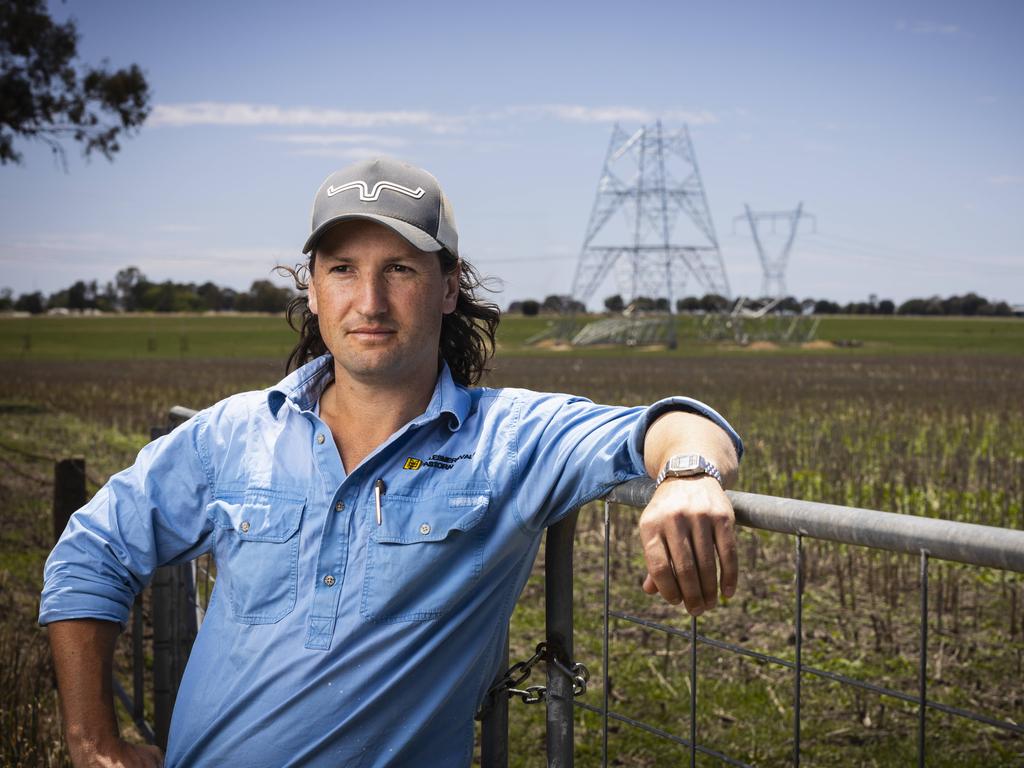‘We’ll fight them at the gate’: Vic farmers vow to step up fight against VNI West transmission project
Victoria’s VNI West electricity interconnector has been hit with a two-year delay as farmers shut their gates and declare: ‘they won’t step foot on my land’.

This is what landholder resistance looks like – an angry red gash on a map along a lengthy stretch of a proposed high-voltage transmission line connecting the electricity grids of Victoria and NSW.
It represents the Victorian farmers standing in the way of the $4bn VNI West project, with each red square denoting paddocks along an indicative transmission path where landholders have said No. Access denied.
And now, as the Victorian government presses ahead with legislation to force access onto private property and penalise defiant farmers, the stakes have been raised even higher.
“We’re united on this and we’ll fight them at the farm gate, if that’s what it comes to,’’ said merino breeder Ben Duxson, a sixth-generation farmer from Marnoo in the Wimmera region.
“We’re prepared and we’re organised and, to be honest, there are people out here quite prepared to go to jail for this. They will not be getting access to our land.’’

Hostility has been fomenting for years over the construction of power lines and transmission towers as part of the 240km Victoria to NSW Interconnector West, known as VNI West, a major plank in the race to harness renewable energy in both states as coal-fired power is retired.
This week, Transmission Company Victoria, the agency set up by the Australian Energy Market Operator to progress the project, announced its timelines would be pushed back two years – from 2028 to a forecast completion in late 2030.
TCV said it needed more time for detailed surveys and “more meaningful landholder engagement on access and easement arrangements”.
What it really meant was that it needed more time to figure out how to deal with these unco-operative and well-organised farmers with their resistance maps and WhatsApp groups and pop-up protests.
“Everyone’s organised around here to get people at their gates pretty quickly and we’ve had some practice runs in recent times,’’ said Mr Duxson, chair of the Wallaloo and Gre Gre District Alliance.
A fortnight ago, word spread that TCV representatives would be attending Buloke Shire offices in Wycheproof, 130km northwest of Bendigo. The next day more than 200 farmers and their supporters gathered outside the council office with placards and speeches, prompting the TCV representatives to cancel their visit due to safety concerns and dial in remotely.

Barry Batters, a farmer from Sutherland in the Wimmera region who will have about 4 km of transmission lines through his property, said the TCV representatives could have turned up, addressed the crowd and answered their questions.
“We’re farmers, we’re not going to bash them or assault them,’’ he said.
It goes to show how little trust there is, on both sides.
The company is hoping to shift sentiment by unveiling new land easement and access packages next week detailing compensation and benefit payments.
About 220 private properties are thought to be affected and it is understood some packages, to be presented to farmers in one-on-one meetings, will be north of seven figures over 25 years.
If money doesn’t smooth the path, the Victorian government has tabled legislation to give energy contractors powers to access private property without consent. Any landholder barring entry will face fines of up to $12,000.
Mr Batters, who worked with other farmers along the proposed route to come up with the map depicting landholder resistance, said he doesn’t believe people who declared their properties off limits would easily shift their positions. He estimated that the red squares on his map represented about 94 landholders.
The proposed easement route has marginally shifted since the map was completed late last year but he said farmers were holding firm. “They move the route and the red squares will move with them,’’ he said.
A TCV spokesperson said about 160 landholders within the preferred 70m-wide easement and the broader (5km) wide draft corridor had signed access agreements to allow field surveys. They were paid up to $50,000 for the arrangement.
Mr Batters said he was convinced farmers in the narrower red zone on his map weren’t for turning. “We talk to people all the time, the ones that we mapped along that first 140km, and they’re still in agreement that they’re not prepared to take on board the line under any conditions.
“I just don’t see how this is ever going to get sorted out because they (TCV) don’t have social licence and they’ve done nothing to get it. We’ve always called for a proper inquiry on the costings of this project but underneath it all we believe it’s the wrong project. If we push it out long enough, then someone might realise it is the wrong project,” he said.
It is understood about 100 property owners have agreed to meet TCV’s liaison workers to discuss their packages. The company would not confirm reports that landholders would be offered $460,000/km on a 100m-wide transmission easement, saying each package was specific to the property and the land use.
Mr Duxson said from his conversations with landholders, big money offers would hold little sway. “They just think that people can be bought out with money and that certainly is not the case here. You’re talking intergenerational farms, you’re talking about people who have a deep love of the land. The more money they throw at us, the more united we become.
“You have to realise this is going through prime agricultural country. This is some of the best food-producing land in the country. There are better alternatives.”
Concerns have also been expressed by the Victorian Farmers’ Federation, and three councils have now come out against the proposed VNI West route which runs from Bulgana, near Stawell, to near Kerang in the north and then across the border into NSW.
Northern Grampians Shire council said in a statement the “vast majority” of the region’s farmers were strongly opposed to the project and called on the Victorian government to find an alternative.
“I am unable yet to understand what benefit this development brings to our shire and its constituents,’’ Councillor Murray Emerson said. “Yes, we need energy as the coal stations are closing, but not at the expense of prime farming land.”
Gannawarra Shire mayor Garner Smith said the costs associated with VNI West “far outweigh the benefits to our communities”.
Buloke Shire Council said in a statement there was strong and widespread opposition to VNI West in its current form and dissatisfaction with the engagement and planning processes. It said it wasn’t just affected landholders who were against the project.
“While some individuals are directly affected by the proposed alignment, many others have voiced concern about broader issues including land use, farmland protection, consultation processes, and the cumulative impact of transmission infrastructure on rural communities.”

A TCV spokesperson said building new transmission lines was a challenging process and “we acknowledge we haven’t always had answers for communities, councils and landholders – and that’s been frustrating.”
The spokesperson said community feedback had changed the way it engaged and more than 250 tower locations had been changed in response to landholder feedback. “We are listening and working with stakeholders to explain why the project is needed, and how people can get involved in order to maximise landholder and community influence on the development of VNI West,” the spokesperson said.
The latest unrest comes as other landholders across the state come to terms with renewable energy projects slated for their areas after the Victorian government recently announced seven dedicated zones involving 5.2 million solar panels, nearly 1000 onshore wind turbines and four transmission projects.
VicGrid, the government body responsible for planning and developing the renewable energy zones, said while these areas covered about 7 per cent of the state, not all this land would host energy infrastructure.
“Many of these projects will also be able to coexist with other land uses. VicGrid has listened and learnt from the agriculture industry to ensure the draft plan minimises impacts and focuses development in areas where farming and renewable energy are believed to be more compatible,” the agency said.
However, some agitated landholders are fighting back and joining in protests with the VNI West farmers and landholders trying to block the Western Renewables link transmission project which was also delayed after AusNet conceded it hadn’t gained access to all sections of the proposed route.
From her property in Karyrie, about 100km north of Horsham, Julie Weir has started her own map to track the farmers who say no to hosting renewable energy infrastructure on their properties.
“The No Rez Map was created to give grassroots farmers, those most impacted by the rollout of renewables, a voice. It’s a live project that is continuing to grow as word spreads and farmers become aware of what’s happening in their area,’’ she said.
The map shows vast areas of red “no” votes from north of Bulgana to Sea Lake in the far north of Victoria.
“The map shows what we already knew, that large numbers of farmers are against hosting renewables on their land.
They don’t want to be in REZ or host any turbines, solar panels, batteries or transmission lines or any associated infrastructure,’’ she said.

State Minister for Energy and Resources Lily D’Ambrosio said last month that communities that hosted renewable energy infrastructure would directly benefit from “substantial investments” generated by these projects.
The government said landowners in the path of transmission lines would receive full and fair compensation under the Land Acquisition and Compensation Act and an additional $8000 per km per year for 25 years.
The government is sensitive to delays in its transmission rollout, a key plank of the state’s target of 95 per cent renewable generation by 2035 and net zero emissions by 2045.








To join the conversation, please log in. Don't have an account? Register
Join the conversation, you are commenting as Logout